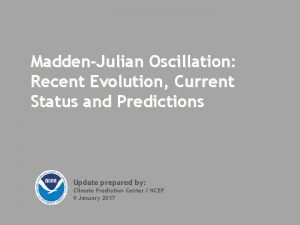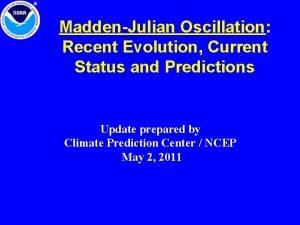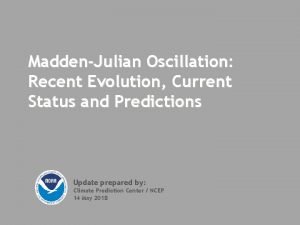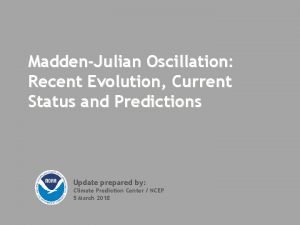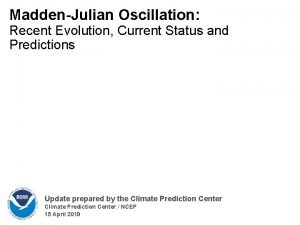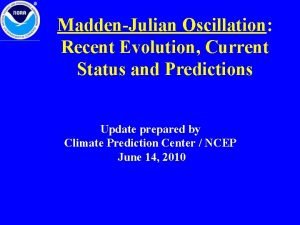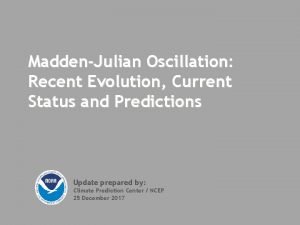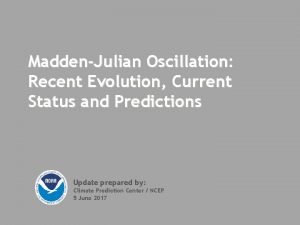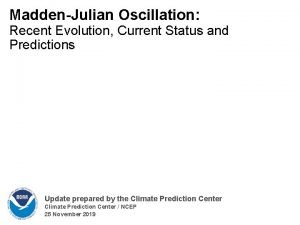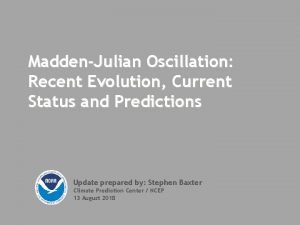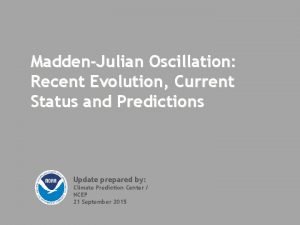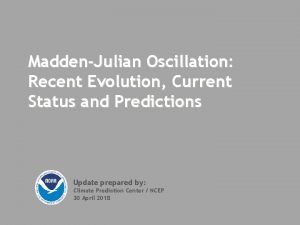MaddenJulian Oscillation Recent Evolution Current Status and Predictions














- Slides: 14

Madden-Julian Oscillation: Recent Evolution, Current Status and Predictions Update prepared by the Climate Prediction Center / NCEP 22 April 2019

Overview As was forecast last week, the past few days have shown renewed MJO activity over the Indian Ocean, though the signal is not robust in many of the variable fields. GEFS and ECMWF forecasts both indicate continued MJO activity through the next two weeks, with a consistent phase speed indicating the signal is likely to reach the western Pacific by the end of Week-2. Although the MJO is likely to affect the state of ENSO on subseasonal time scales, the low frequency El Niño signal will continue to play a dominant role in the evolution of the global tropical convective pattern during the Boreal Spring months. A discussion of potential impacts for the global tropics and those related to the U. S. are updated on Tuesday at: http: //www. cpc. ncep. noaa. gov/products/precip/CWlink/ghazards/index. php

200 -h. Pa Velocity Potential Anomalies Green shades: Anomalous divergence (favorable for precipitation). Brown shades: Anomalous convergence (unfavorable for precipitation). • • • The MJO, which was consistently active throughout the fall and winter, became inactive during mid-March. Since the beginning of March, the pattern has been dominated by low-frequency signals, with some modulation by Rossby and Kelvin wave activity. Mid-April shows the beginning of renewed eastward propagation; however, the spatial pattern shows a very noisy 200 -h. Pa field with no clear subseasonal signal.

200 -h. Pa Wind Anomalies Shading denotes the zonal wind anomaly. Blue shades: Anomalous easterlies. Red shades: Anomalous westerlies. • • • As seen in the upper-level VP field on the previous slide, the MJO became inactive during mid-March. Anomalous cross-equatorial flow has set up over near 160 W on the Equator in the past week, breaking up the anomalous westerlies seen over previous weeks. Most anomalies along the equator have weakened, especially the convergence in the Indian Ocean.

850 -h. Pa Wind Anomalies Shading denotes the zonal wind anomaly. Blue shades: Anomalous easterlies. Red shades: Anomalous westerlies. • • • The low-level wind field shows the potential of the re-emerging MJO signal over the Indian Ocean. Westerly wind anomalies over the east-central Pacific have strengthened in the past week, but still remain unimpressive and disorganized. The extratropical pattern over the Northern Hemisphere has weakened, with a breakdown in the anti-cyclone off the western coast of North America. Transport across the Equator is weak.

Outgoing Longwave Radiation (OLR) Anomalies Blue shades: Anomalous convection (wetness). Red shades: Anomalous subsidence (dryness). • • The low-frequency active convection around the Date Line continued into April, and has been the most consistent signal during 2019. Several modes of variability (Kelvin, Rossby and MJO) are present over the Indian Ocean, where the RMM index indicates the convective envelope of the MJO is re-emerging. The Kelvin wave is likely to constructively interfere with the MJO signal and aid in eastward propagation.

SSTs and Weekly Heat Content Evolution in the Equatorial Pacific • • • SST anomalies remain above climatology across much of the equatorial central and east Pacific, consistent with an El Niño event. In the far eastern Pacific, weak negative anomalies emerged mid-April, impacting the Nino 1+2 index; however, these anomalies appear to already have disappeared, likely impeded by the strengthening of westerly wind anomalies along the equatorial eastern Pacific. Positive oceanic heat content anomalies have been observed over most of the Pacific basin since last April, with a decrease in the strength of the anomalies over the West Pacific in 2019.

MJO Index: Recent Evolution • The RMM index depicts an incoherent signal through most of March and April. It appears that the signal has started to re-emerge over the Indian Ocean in the past few days. • Influences from the low-frequency signal, as well as from higher frequency variabilities, has likely led to weak projection onto the RMM index and this period of inactivity of the MJO signal.

MJO Index: Forecast Evolution GEFS Forecast • • ECMWF Forecast The GEFS favors renewed MJO activity, with a quick amplification of the signal over the Indian Ocean, likely due to constructive interference with other modes of variability. The signal weakens, but remains active through the next two weeks. The ECMWF shows a more conservative solution for the re-emerging signal, but also continues eastward propagation through the coming weeks. As the signal reaches the Western Pacific, likely interference with the El Nino event leads to a decline in the signal. It should be noted the spread among the ensemble members for the ECMWF solution is fairly wide.

MJO: GEFS Forecast Evolution Figures below show MJO associated OLR anomalies only (reconstructed from RMM 1 and RMM 2) and do not include contributions from other modes (i. e. , ENSO, monsoons, etc. ) • • Consistent with the RMM forecasts, enhanced convection is forecast to develop over the Indian Ocean during the next weeks, propagating over the Maritime Continent in Week-2. The suppressed convection forecast over the west-central Pacific would represent a significant pattern shift.

MJO: Constructed Analog Forecast Evolution Figures below show MJO associated OLR anomalies only (reconstructed from RMM 1 and RMM 2) and do not include contributions from other modes (i. e. , ENSO, monsoons, etc. ) • The constructed analog features a very similar solution as the GEFS, albeit maintaining a slightly slower phase speed.

MJO: Tropical Composite Maps by RMM Phase 850 -h. Pa Velocity Potential and Wind Anomalies (Nov - Mar) Precipitation Anomalies (Nov - Mar)

MJO: CONUS Composite Maps by RMM Phase - Temperature Left hand side plots show temperature anomalies by MJO phase for MJO events that have occurred over the three month period in the historical record. Blue (orange) shades show negative (positive) anomalies respectively. Right hand side plots show a measure of significance for the left hand side anomalies. Purple shades indicate areas in which the anomalies are significant at the 95% or better confidence level. More information: http: //www. cpc. ncep. noaa. gov/products/precip/CWlink/MJO/mjo. shtml

MJO: CONUS Composite Maps by RMM Phase - Temperature Left hand side plots show precipitation anomalies by MJO phase for MJO events that have occurred over the three month period in the historical record. Brown (green) shades show negative (positive) anomalies respectively. Right hand side plots show a measure of significance for the left hand side anomalies. Purple shades indicate areas in which the anomalies are significant at the 95% or better confidence level. More information: http: //www. cpc. ncep. noaa. gov/products/precip/CWlink/MJO/mjo. shtml
 A balanced delta connected load having an impedance 20-j15
A balanced delta connected load having an impedance 20-j15 Difference between phase voltage and line voltage
Difference between phase voltage and line voltage Drift current and diffusion current in semiconductor
Drift current and diffusion current in semiconductor Line current and phase current
Line current and phase current Drift current and diffusion current in semiconductor
Drift current and diffusion current in semiconductor Drift current and diffusion current
Drift current and diffusion current In a ∆-connected source feeding a y-connected load
In a ∆-connected source feeding a y-connected load Slideplayer
Slideplayer Diffusion current formula
Diffusion current formula Size separation objective
Size separation objective The value of vgs that makes is approximately zero
The value of vgs that makes is approximately zero Dcep welding
Dcep welding Hazard based safety engineering
Hazard based safety engineering Kcl mesh analysis
Kcl mesh analysis Current program status register
Current program status register















